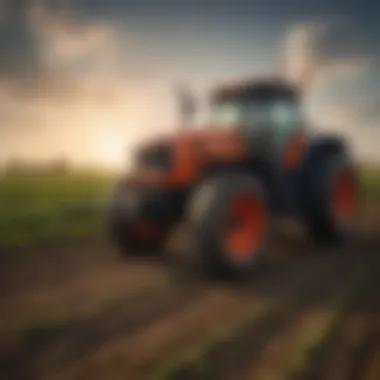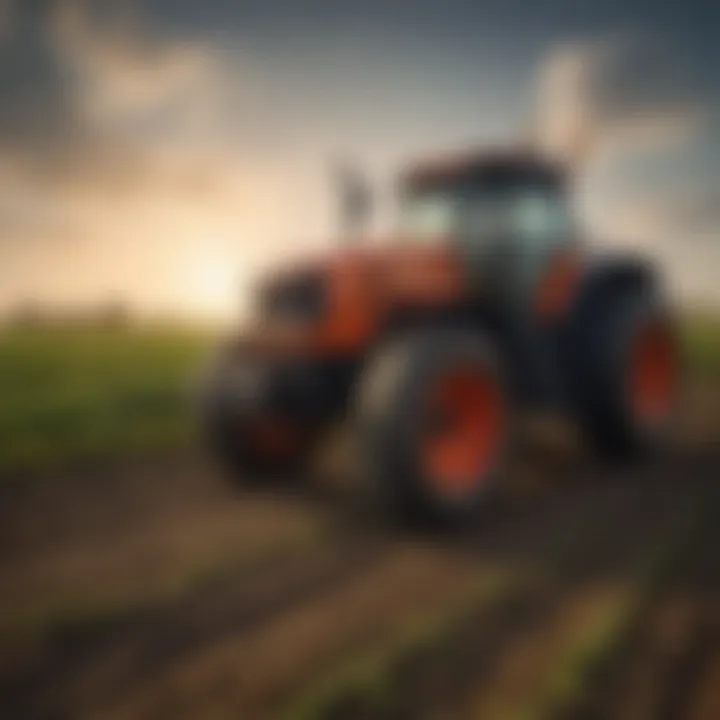Exploring the Parmak 12: Transforming Agriculture


Intro
The field of agriculture continuously evolves as new technologies emerge to address the challenges faced by farmers. One such innovation is the Parmak 12, a device specifically designed to enhance agricultural efficiency. This article aims to provide a thorough examination of the Parmak 12, delving into its design and functionality while exploring its practical applications in the farming sector. Below, we will delve into the essential concepts and terminology surrounding this innovative technology.
Key Concepts and Terminology
Basic Definitions
The Parmak 12 is a sophisticated agricultural tool that aims to optimize various farming processes. At its core, the device integrates advanced technology to improve crop monitoring, pest control, and resource allocation. Knowing the key terms associated with this technology is crucial for understanding its impact on modern farming practices.
- Agricultural Efficiency: Refers to the capacity to maximize output while minimizing input resources. This is important for achieving sustainable farming.
- Crop Monitoring: Involves tracking plant health and growth stages using data-driven insights to make informed decisions.
- Resource Allocation: The strategic distribution of resources such as water, fertilizers, and labor based on precise needs.
Historical Context
Understanding the historical background of agricultural technology sheds light on the significance of innovations like the Parmak 12. Agriculture has witnessed numerous technological advancements over the decades, ranging from mechanization to the application of data analytics. The introduction of electronic devices in farming began in the late 20th century, marking a shift towards precision agriculture. With the rise of computers and technology, tools have become more intricate and effective, paving the way for devices like the Parmak 12.
Recent Innovations and Trends
Technological Advancements
In analyzing the Parmak 12, one can identify several key technological advancements that allowed its development. This includes the integration of sensors for real-time data collection, machine learning algorithms for predictive analytics, and communication systems for interconnectivity. These features work synergistically to enhance decision-making in the field.
Sustainable Practices
As agriculture faces increasing pressure from environmental challenges, practices focusing on sustainability are becoming more vital. The Parmak 12 promotes sustainable farming by optimizing input usage—thus reducing waste and environmental impact. By facilitating precision farming techniques, it aligns well with the ongoing movement towards eco-friendly agricultural methodologies.
Practical Applications and Techniques
Step-by-step Guides
Integrating the Parmak 12 into farming practices involves several steps. Farmers should consider the following:
- Assessment of Needs: Evaluate specific areas requiring improvement.
- Installation: Follow manufacturer guidelines to set up the Parmak 12 efficiently.
- Data Collection: Utilize sensors to gather relevant crop and environmental data.
- Analysis: Apply analytical tools to interpret the data for actionable insights.
- Adjust Practices: Modify practices based on findings to enhance efficiency.
Case Studies
The implementation of the Parmak 12 has shown promising results in various contexts. For example, farms that have adopted this technology report better yield predictions leading to increased profitability. The effectiveness of pest management through targeted interventions also highlights its practical benefits.
"With the Parmak 12, farmers can achieve significant improvements in both yield and resource management. It represents a leap forward in agricultural technology."
Overall, the Parmak 12 stands as a testament to the innovations shaping the future of agriculture. By facilitating better practices and contributing to sustainability, this device plays a crucial role in modern farming.
Foreword to Parmak
The Parmak 12 represents a significant advancement in agricultural technology. Understanding the importance of this device is crucial for farmers and agricultural enthusiasts. The Parmak 12 is designed to improve efficiency and productivity in farming practices. Its unique features and functions make it a vital tool in today's competitive agricultural environment.
Definition and Purpose
The Parmak 12 is primarily a smart irrigation system, integrating modern technology to automate the watering of crops. The purpose of the Parmak 12 is to optimize crop irrigation, helping farmers ensure that their plants receive adequate water without wastage. This device uses sensors to monitor soil moisture levels and adjust water supply accordingly. By doing so, the Parmak 12 not only conserves water but also promotes healthier crop growth, leading to better yields.
Historical Context
The evolution of irrigation systems has a rich history. Traditional methods often relied on manual labor and natural rainfall. However, the increasing demand for food and the challenges posed by climate change have fueled the need for more advanced solutions. The Parmak 12 emerges from this context as a response to modern agricultural challenges. Innovations in agricultural technology over recent decades have paved the way for devices like the Parmak 12, which combine efficiency with sustainability. This journey from rudimentary practices to sophisticated systems highlights the ongoing transformation within the industry.
Technical Specifications of Parmak
Understanding the technical specifications of the Parmak 12 is crucial for appreciating its role in modern agriculture. These specifications not only highlight the efficiency and effectiveness of this innovative device but also provide essential insights into its design philosophy and operational capabilities. Farmers and practitioners can better grasp how tools like the Parmak 12 can be integrated into their practices by analyzing these technical elements.
Design Features
The design features of the Parmak 12 reflect a thoughtful blend of functionality and practicality. This device has been developed to address the complexities of agricultural tasks.
- Ergonomic Structure: The Parmak 12 showcases an ergonomic design. This facilitates ease of use during long hours of operation, ensuring that discomfort is minimized for the user.
- Durable Materials: Constructed from high-quality, weather-resistant materials, the Parmak 12 is built to withstand various environmental conditions. This durability contributes to its longevity and reliability on the field.
- Compact Design: Its compact size allows for easier maneuverability within different agricultural settings, making it suitable for a range of crops and terrains.
- Modularity: Many components of the Parmak 12 are interchangeable. This modularity enables users to adapt the device for specific tasks, increasing its versatility.
These features manifest the commitment to creating a tool that meets the needs of modern agriculture, enhancing the efficiency of farming operations.


Functional Components
The functional components of the Parmak 12 play a pivotal role in its operational effectiveness. Each component is engineered to work in harmony, enhancing the overall performance of the device.
- Hydraulic System: A state-of-the-art hydraulic system drives the operational capabilities of the Parmak 12. This system provides strong lifting and maneuvering power, essential for doing heavy tasks.
- Control Panel: An intuitive control panel allows users to manage various functions seamlessly. Feedback from this panel ensures that operators are always informed about the device's status.
- Sensor Technology: Integration of advanced sensor technology enhances the Parmak 12's ability to monitor soil conditions and crop health. This feature ensures that necessary adjustments can be made in real-time, increasing efficiency and productivity.
- Power Source: The Parmak 12 is equipped with an energy-efficient power source. This design consideration aligns with the growing emphasis on sustainability in agriculture, reducing the carbon footprint associated with its use.
By examining these functional components, it is evident that the Parmak 12 is meticulously designed to provide comprehensive support for diverse agricultural needs.
"The Parmak 12 embodies innovation in agricultural technology, breaking down barriers to efficiency and productivity."
Operational Mechanisms
Operational mechanisms are critical in understanding how the Parmak 12 functions within modern agricultural settings. This section provides insights into the essential components that ensure efficient operation. Recognizing these mechanisms helps farmers and technology enthusiasts appreciate the importance of such systems in optimizing agricultural outputs.
How Parmak Works
The functioning of the Parmak 12 is grounded in its innovative design that integrates various technologies to streamline agricultural processes. At its core, the device operates through sensor-based technology, which collects real-time data on environmental conditions. This data is then analyzed to inform decision-making related to crop management.
The core operational principles of the Parmak 12 can be summarized as follows:
- Data Collection: The sensors embedded in the device monitor several parameters including soil moisture, temperature, and humidity. This information allows farmers to make informed choices about irrigation and fertilization.
- Automated Responses: Based on data analysis, the Parmak 12 can automate various processes such as triggering irrigation systems or adjusting nutrient delivery.
- User Interface: The device features a user-friendly interface that allows farmers to customize settings according to their specific crop needs, ultimately enhancing usability.
Each of these components not only augments efficiency but also enables real-time responses to changing agricultural conditions. This adaptability is vital in achieving high productivity while adhering to sustainable practices.
Control Systems
Control systems in the Parmak 12 play a pivotal role in ensuring that all operations are executed smoothly. These systems manage how the components of the device interact with one another and respond to user input.
Key aspects of the control systems include:
- Central Processing Unit (CPU): The heart of the operational mechanism, the CPU processes data inputs swiftly and ensures that the correct actions are taken based on real-time readings.
- Feedback Systems: The feedback loops established within the control systems allow for continuous monitoring and adjustment. If conditions change quickly, such as an unexpected rainfall, the system can recalibrate operations accordingly.
- Remote Access: Farmers can control the Parmak 12 remotely through a smartphone application. This feature not only provides convenience but also enhances resource management from anywhere, anytime.
Effective control systems ensure that the Parmak 12 operates efficiently and adapts to climatic changes, leading to more sustainable farming outcomes.
Understanding these operational mechanisms sheds light on how technology is revolutionizing agriculture. The integration of advanced systems like those in the Parmak 12 illustrates a clear shift towards smarter farming.
Application in Modern Agriculture
The application of the Parmak 12 in modern agriculture signifies a pivotal shift in how farming practices are conducted today. As the agricultural industry faces numerous challenges such as climate change, resource scarcity, and rising global food demand, integrating advanced technologies like the Parmak 12 becomes essential. This implementation not only promises an enhancement in productivity but also addresses sustainability and resource management more effectively.
Crop Management
Effective crop management is vital for ensuring high yield and quality produce. The Parmak 12 contributes significantly to this process through its precision agriculture capabilities. It enables farmers to monitor and control various growth conditions in real-time. For example, features embedded in Parmak 12 facilitate soil moisture sensing and nutrient tracking. This allows for targeted irrigation and fertilization, which can lead to optimal plant health and increased harvests.
Farmers using the Parmak 12 report better outcomes by leveraging its data analytics features. They can analyze weather patterns and soil conditions to decide the best time for planting and harvesting. This informed decision-making results in stronger crop cycles and minimizes the risks associated with crop failure due to unforeseen weather events or soil degradation.
Efficiency Enhancement
Efficiency in agricultural operations can translate directly into cost savings and higher productivity levels. The Parmak 12 is not just a tool but a comprehensive solution that streamlines various farming processes. By automating tasks such as crop monitoring, resource allocation, and machinery operation, the device reduces the manual workload on farmers, allowing them to focus on strategic decisions rather than routine tasks.
Implementing the Parmak 12 leads to significant improvements in resource utilization. For instance, utilizing water-saving technologies integrated within the device ensures that every drop of water used is efficient. According to user experiences, employing the Parmak 12 has led to reduction in water usage by up to 30%. This not only conserves valuable resources but also lowers operational costs, making farms more sustainable.
"The use of the Parmak 12 has changed how we approach farming. It’s not just a device; it’s like having a partner in the field providing insights and guidance." - A review from an agricultural expert.
Efficiency is further enhanced through seamless integration with existing farm machinery. The device's compatibility with other technological advancements means that farmers can upgrade their operations without overhauling their entire system. As a result, the Parmak 12 represents a blend of innovation and practicality, which empowers modern agriculture to keep pace with evolving challenges and demands.
Advantages of Using Parmak
The Parmak 12 presents significant advantages that enhance its appeal to farmers and agricultural enthusiasts alike. These benefits are rooted in the device's capacity to drive efficiency in operations, which is crucial in today's competitive agricultural landscape. By understanding and leveraging these advantages, users can optimize their agricultural practices and contribute positively to their outcomes.
Increase in Productivity
One of the most compelling benefits of the Parmak 12 is its ability to significantly boost productivity on farms. This device offers advanced functionalities that streamline various farming processes. For instance, it engages with precision farming techniques that optimize the application of inputs such as water and fertilizers. This leads to a more effective use of agricultural resources. Farmers report higher crop yields owing to the targeted interventions facilitated by the Parmak 12. Moreover, the automated systems reduce labor intensity, allowing workers to focus on other essential tasks, thus maximizing overall operational efficacy.
Reduction in Resource Waste
The utilization of the Parmak 12 also ensures a marked decrease in resource waste. Traditional farming methods often lead to overuse or inefficient use of vital resources. The Parmak 12 combats this inefficiency through its innovative design, which incorporates smart monitoring and control systems. These systems provide real-time data that allows farmers to adjust their practices accurately. As a result, water and nutrients are used judiciously, minimizing both excess expenditure and environmental impact. Such precision in resource management not only contributes to sustainability but also improves the long-term viability of agricultural operations.


In summary, the adoption of Parmak 12 leads to improved productivity and reduced wastage, essential elements for sustainable farming today.
Incorporating the Parmak 12 into farming practices thus presents a pathway not only towards increased agricultural output but also towards responsible resource management.
Challenges and Limitations
Understanding the challenges and limitations of the Parmak 12 is critical for stakeholders in agricultural technology. The innovations offered by this device hold great promise; however, recognizing its constraints is essential for effective integration into farming practices. This section delves into both technical limitations and the hurdles relating to user adaptation, providing insights needed to maximize the benefits of the Parmak 12 while also preparing users for potential obstacles.
Technical Limitations
While the Parmak 12 presents numerous advances, it is not devoid of technical challenges. One significant limitation concerns its reliance on digital technology, which is vulnerable to connectivity issues. If internet access is poor or inconsistent in certain agricultural areas, then farmers may find themselves unable to optimize its functionalities. This kind of disruption can halt operations, rendering technology less effective than intended.
Another area of concern is the hardware. Although built with high-quality materials, the Parmak 12 can be susceptible to wear and tear in rugged agricultural environments. Factors such as moisture, soil, and extreme weather conditions can compromise the device’s sensors and other components over time, leading to decreased performance.
Additionally, its complexity might intimidate some users. Farmers accustomed to traditional methods may find the transition to a digital solution challenging. Without proper training or support, they may underutilize the instrument's capabilities, resulting in suboptimal performance.
User Adaptation Issues
The successful implementation of the Parmak 12 depends significantly on how users adapt to its technology. The shift from conventional practices to a more technologically driven approach can be daunting, especially for older generations of farmers who may be less familiar with digital devices.
User education is paramount. Many farmers require comprehensive training to understand how to best utilize the Parmak 12’s features. If this educational component is lacking, users may struggle to engage with the technology effectively. Moreover, there may be a resistance to change ingrained habits. Established practices often carry a sense of comfort and reliability, making it difficult for users to embrace new methods.
Furthermore, varying skill levels among users pose challenges. Not every farmer will possess the same level of technical expertise. This disparity can lead to frustration among those who find the device complex, further hindering its successful application in diverse agricultural settings.
In summary, while the Parmak 12 serves as a transformative tool for modern agriculture, its technical limitations and user adaptation issues present valid challenges. Acknowledging these setbacks is crucial for optimizing its use and ensuring that agricultural operations can reap the full benefits of this advanced technology.
"Adapting to technological innovations is as important as the technology itself in achieving sustainable agricultural practices."
Comparative Analysis
In this section, we delve into a comparative analysis of the Parmak 12 against other agricultural technologies. This analysis is crucial as it helps to highlight the unique attributes and effectiveness of the Parmak 12 when measured against competitors. Understanding these differences enables farmers and agricultural enthusiasts to make informed decisions about technology adoption in their practices.
Parmak vs. Other Technologies
The Parmak 12 stands out in a crowded market of agricultural tools and devices. It offers features that are often absent in competing products.
- Efficiency: Many traditional systems can be cumbersome and less effective. Parmak 12 streamlined processes significantly, reducing the time and labor involved in day-to-day operations.
- Integration: The Parmak 12 interfaces well with existing systems unlike some other technologies that require extensive rebuilding or retrofitting to work. This ease of integration is a major benefit for farmers looking to upgrade.
- Data Utilization: It possesses advanced data analytics capabilities, which far exceed most current technologies. This feature allows farmers to make better decisions based on real-time data.
- User-Friendliness: Training on the Parmak 12 is generally shorter compared to its competitors, making it accessible for all levels of users.
Market Position
The market position of Parmak 12 is indicative of its acceptance and reliance within the agricultural sector. Several elements contribute to its strong standing in this industry.
- Market Share: Parmak 12 continues to gain substantial market share, suggesting high demand and user satisfaction. This is evidenced by increasing sales figures and repeat purchases.
- Reputation: The device holds a favorable reputation among professionals in agriculture. It is praised for its reliability and innovation, qualities that resonate deeply within a trust-based community like farming.
- Feedback Loop: Companies behind the Parmak 12 actively engage with their user base to refine the product continuously. This responsiveness has positioned it favorably against less adaptive technologies.
"A comparative analysis not only reveals strengths but also guides improvements in technology. Understanding where products stand relative to each other is key for agricultural advancement."
The comparative discussion serves to reinforce the advantages of adopting the Parmak 12. It provides farmers not just with metrics, but real-world implications of choosing the right tools for their operations.
Future Trends in Agricultural Technology
The conversation on agricultural technology is evolving quickly. Understanding the future trends within this field is vital not only for manufacturers and developers but also for farmers and enthusiasts who directly interact with these advancements. Focusing on the trends allows stakeholders to anticipate shifts in practices and capitalize on new techniques that can enhance productivity and sustainability.
Emerging Technologies
A myriad of emerging technologies is set to reshape the landscape of agriculture. These innovations include precision farming tools, robotics, and the integration of artificial intelligence. Precision farming employs data analytics to optimize field-level management regarding crop farming. Farmers can utilize sensors and GPS to monitor fields and apply inputs more efficiently, which results in improved crop yields.
Robotics is another sector making waves. Devices like autonomous tractors and drones can perform repetitive tasks quickly and accurately. The adaptation of these technologies leads to not only cost savings but also a reduction in physical labor demands, which are increasingly vital in an industry facing labor shortages.
The application of artificial intelligence can also enhance decision-making processes in farming. AI can analyze vast amounts of data and predict outcomes like crop performance, pest infestations, and weather impacts. This predictive capability allows for timely actions that can mitigate losses and maximize gains, creating a more resilient agricultural system.
"Adopting emerging technologies leads to significant advancements in productivity and operational efficiency."
Sustainability Considerations
Sustainability in agricultural practices is more crucial than ever. As the global population grows, the demand for food increases, putting more pressure on natural resources. Future trends emphasize the need for sustainable practices that not only meet these demands but also protect ecological balance.


Innovations focused on reducing carbon footprints and improving resource efficiency will be paramount. Technologies such as vertical farming and hydroponics are gaining traction due to their ability to produce food with reduced land and water usage. These methods are designed to minimize environmental impact while providing high yields.
Furthermore, integrated pest management utilizing natural predators and bio-pesticides will likely become more commonplace. Farmers will prioritize methods that enhance biodiversity and reduce chemical dependency.
In summary, the focus on sustainability within agricultural technology is not simply a trend but a necessary evolution. This shift can foster resilience in farms and contribute positively to environmental stewardship, which is increasingly recognized as essential for the future of food production.
Understanding these potential futures equips farmers and agricultural professionals to adopt practices that align with both emerging technologies and sustainability goals.
Case Studies of Parmak Implementation
The examination of Parmak 12 through case studies provides vital insights into its practical applications within agricultural operations. Case studies not only showcase tangible results but also reveal the circumstances under which Parmak 12 excels. These practical examples serve to underline the device's potential to enhance productivity, efficiency, and resource management in farming.
Successful Applications
In various regions, Parmak 12 has been in use ranging from small farms to large agricultural enterprises. For instance, a case study from an organic farming operation in California illustrates how implementing Parmak 12 led to a 30% increase in crop yield. The farmers integrated the device into their irrigation systems, enhancing water distribution and reducing wastage. This application not only improved crop health but also lowered operational costs related to water usage.
Another significant implementation occurred in a large commercial farm in Texas. By employing the Parmak 12 technology, they adjusted their fertilizer application more precisely. This led to a marked improvement in soil health and a reduction in the overall amount of fertilizers used. Consequently, they reported savings of approximately 20% in fertilizer costs within the first year of integrating Parmak 12.
Lessons Learned
The experiences gleaned from the implementation of Parmak 12 have yielded several valuable lessons for agricultural practitioners. One of the primary takeaways is the necessity for careful planning during integration. For instance, initial resistance from employees was observed due to the shift from traditional methods. A well-structured training program was essential for overcoming this challenge. This highlights the importance of equipping the workforce with the necessary skills and knowledge to operate advanced agricultural technologies effectively.
Furthermore, some case studies have illustrated that continuous monitoring is crucial. In one instance, a farm faced issues with starting the device. By promptly addressing these unexpected technical barriers through regular maintenance, the farm significantly reduced downtime, ensuring that productivity remained high.
"The strategic integration of technology like Parmak 12 can revolutionize farming operations, leading to both increased yields and sustainable practices."
User Feedback and Experiences
User feedback is a crucial aspect in understanding the effectiveness and practicality of the Parmak 12 in agricultural settings. Insights gleaned from the experiences of actual users provide valuable information on how this device operates under real-world conditions. This section details the various elements of user reviews and expert opinions, which together paint a fuller picture of the Parmak 12’s role in modern agriculture.
User Reviews
User reviews of the Parmak 12 reveal a mix of satisfaction and areas for improvement. Many farmers appreciate the device’s ability to streamline certain agricultural processes. Some notable points from user experiences include:
- Efficiency Gains: Users frequently highlight how the Parmak 12 enhances productivity, allowing for quicker decision-making and implementation in the field.
- Ease of Use: Several farmers mention the intuitive interface, making it relatively easy to integrate into their existing workflows. This appeals particularly to those who may not be as technologically inclined.
- Durability: Positive feedback often emphasizes the build quality and durability of the Parmak 12, indicating it can withstand the rigors of agricultural environments.
However, not all feedback is overwhelmingly positive. A few users report issues related to software glitches or connectivity problems. This feedback suggests a need for ongoing software updates and maintenance plans to ensure optimal performance.
"The Parmak 12 has transformed how I manage my crops, but I do wish updates were more frequent to fix the occasional glitch."
Expert Opinions
Expert opinions provide an additional layer of analysis, focusing on the technical and operational aspects of the Parmak 12. These insights come from agricultural technologists, industry analysts, and seasoned farmers who study the impact of technological advancements on farming practices. Key points from expert discussions include:
- Integration Challenges: Experts note that while the Parmak 12 is a powerful tool, its integration into existing farming practices can pose challenges. Training and adaptation periods may be necessary to maximize its utility.
- Impact on Yield: Many experts agree that there is a potential for increased crop yield through the use of the Parmak 12. The device helps in monitoring crop health and environmental conditions, allowing for timely interventions.
- Future Developments: Some experts are optimistic about the future upgrades planned for the Parmak 12. Improvements in artificial intelligence and data analytics could lead to even more refined functionalities that benefit users significantly.
In summary, user feedback and expert opinions provide essential insights into the Parmak 12’s performance and its implications for modern agriculture. These perspectives help identify both strengths and areas needing attention, fostering informed decisions about technology adoption in farming.
Culmination
In the realm of agricultural technology, the Parmak 12 stands out as a significant innovation. The importance of this device is not merely in its advanced design, but in the way it influences farming practices and contributes to greater efficiency.
Summary of Findings
The article's exploration of the Parmak 12 highlights several key findings. It presents a detailed examination of its technical specifications, operational mechanisms, and real-world applications. The data suggests that implementing the Parmak 12 can lead to a substantial increase in crop yields. This device integrates various functional components to optimize plant growth conditions, including improved soil management and resource utilization. Farmers who adopt this technology frequently report enhanced productivity and reduced operational costs. It's clear that the Parmak 12 offers innovative solutions to traditional farming challenges.
Implications for the Future
Looking ahead, the implications of the Parmak 12 are profound. As agricultural demands increase globally, the need for innovative solutions like the Parmak 12 will grow. Its design principles can serve as a foundation for future advancements in agricultural technology. Moreover, sustainable practices embedded within the device support environmental responsibility. This aligns with the global shift towards more sustainable agricultural methods. Farmers and technology developers should continue to engage with these innovations to achieve resilient and productive agricultural systems. Thus, the Parmak 12 is not just a current tool but a stepping stone toward ongoing improvements in farming practices overall.
Citing Sources
Citing sources establishes transparency in the information presented. It reveals the origins of data and ideas, helping readers trace back through research studies, technical documents, or industry reports. This practice fosters trust and encourages further investigation of the Parmak 12. Readers looking to expand their knowledge might find it beneficial to investigate the publications listed in the references.
Effective citation also enables scholars, farmers, and technology enthusiasts to compare findings and enhance their own practices. As they dive into the materials referenced, they can uncover new insights about the applications and innovations surrounding the Parmak 12.
Suggested Further Reading
For those interested in delving deeper into the subject of agricultural technology and the specific implementations of the Parmak 12, several resources can provide valuable insights. Here is a selection of recommended readings:
- Wikipedia: Agricultural Technology
- Britannica: & Agricultural Innovation
- Reddit discussions on farming innovations
- Relevant articles and updates available on platforms like Facebook.
Engaging with these sources will enhance understanding and encourage thought-provoking question about the future of agricultural technology and devices like the Parmak 12. The interplay of theory and practice in these readings will empower farmers and enthusiasts to make informed decisions about adopting new technologies.















